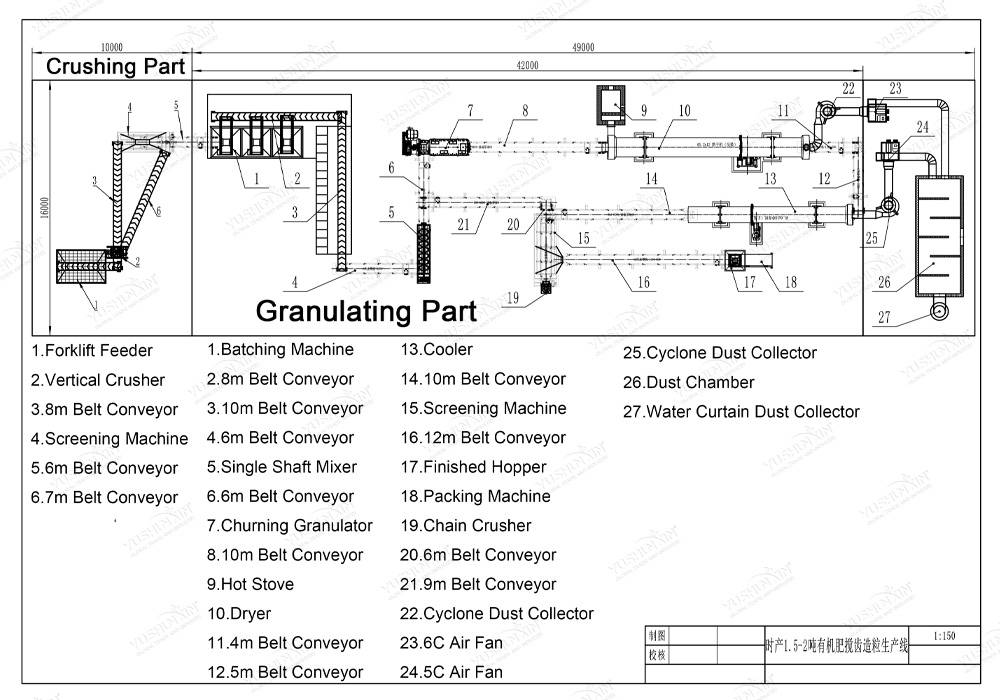







Ngonversi Rock fosfat menyang wangun pupuk sing bisa digunakake, asam dibutuhake kanggo “fizzy” rock, senyawa fosfor larut larut. Asam umum sing digunakake kalebu:
Kanggo nggawe Pupuk npk, Sumber nitrogen lan kalium bisa dicampur karo bahan fosfat. Sawetara conto kalebu:
Biaya baris produksi beda-beda gumantung karo kapasitas produksi, Gelar automasi, lan kabutuhan khusus. Isi formulir ing ngisor iki lan kita bakal nyedhiyani sampeyan kutipan sing akurat!
Yen sampeyan kepengin weruh peralatan nggawe pupuk, Kirimake syarat lan kontak sampeyan banjur kita bakal ngubungi sampeyan rong dina. Kita janji yen kabeh informasi ora bakal bocor karo sapa wae.
- Perusahaan kasebut diadegake 2005 lan wis fokus ing riset lan pangembangan lan pabrik peralatan pupuk organik kanggo 20 taun. Wis mbangun dhasar produksi organik ukuran 40.000m kanthi ukuran, Nggunakake Granulasi Advanced, Teknologi pangatusan lan screening kanggo nambah efisiensi produksi lan kualitas produk.
- Impor impor lan ekspor perusahaan kanthi luwih saka 80 Engineer Profesional ing Worldwide, ngladeni luwih saka 100 Negara lan Wilayah ing saindenging jagad, 5,000+ Kasus layanan pelanggan, 10 Pusat Pangolahan, 3 mesin nglereni laser, lan luwih saka 60 Peralatan macem-macem jinis.
- Njaga kerjasama sing jangka panjang lan ekstensif karo akeh institusi lan universitas ilmiah, with a professional R&D team, Bisa terus-terusan ngoptimalake kinerja peralatan miturut permintaan pasar.
- Bahan-bahan tahan kekuatan dhuwur, wesi baja karbon q235 / wesi dipilih kanggo mesthekake yen peralatan kasebut awet tahan lama lan nyuda biaya pangopènan.
- Nganggo sistem kontrol cerdas kanggo nambah level otomatis otomatis lan nyuda katergantungan manual.
- ISO, Ce, Sertifikasi internasional SGS
- Kanthi kapasitas produksi ukuran gedhe, Bisa nyukupi syarat kapasitas produksi sing beda (Cilik, Garis produksi medium lan gedhe).
- Macem-macem model peralatan, Cocog kanggo produksi macem-macem jinis pupuk kayata pupuk organik, senyawa pupuk, pupuk biologis, Pupuk larut banyu, Cairan pupuk, lsp.
- Desain pribadi bisa diwenehake miturut kabutuhan pelanggan, kalebu kapasitas produksi, Tata letak situs, standar perlindungan lingkungan, lsp.
- Wenehi pesawat lengkap line produksi lengkap, kalebu pilihan peralatan, Instalasi lan Komisi, Latihan Teknis, lsp.

- Pasokan pabrik langsung, Ngurangi link MiddleMan, lan regane luwih kompetitif.
- Peralatan kasebut duwe efisiensi energi dhuwur, Nyuda Konsumsi Energi, Lan mbantu para pelanggan nyuda biaya operasi jangka panjang.
- Pasokan pabrik langsung, Ngurangi link MiddleMan, lan regane luwih kompetitif.
- Peralatan kasebut duwe efisiensi energi dhuwur, Nyuda Konsumsi Energi, Lan mbantu para pelanggan nyuda biaya operasi jangka panjang.
Nyediakake mesin pupuk polonging menyang produsen pupuk pupuk ing Walanda
Pangiriman sukses saka granulator 1t / H kaping pindho kanggo klien ing Turki lan Inggris
Solusi kompos kompos sing efisien dikirim menyang klien Filipina
Pangiriman granulator disk menyang klien chilean kanggo produksi pupuk
Singkatan Pelletizing Efficiency Kanggo Gooddeart Group, Afrika Kidul